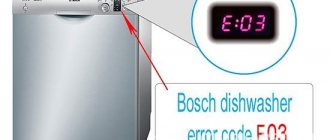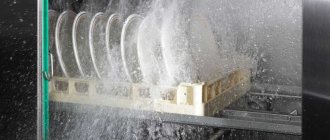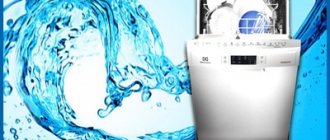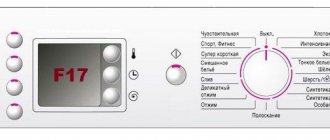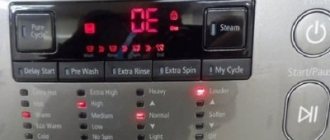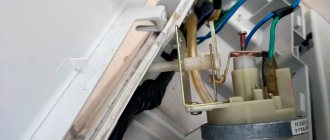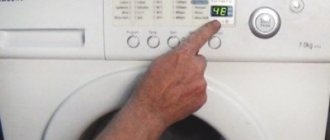Filter problem
If you do not wash the filter in time and food remains are stuck in the machine, the pump may not be able to cope with the task of pumping out water, thereby causing a breakdown. The same situation can arise if the plastic structure of the filter breaks.
This problem will be solved by simply cleaning the filter and possibly replacing it (in the event of a structural failure).
The water level sensor is broken
Symptoms: water begins to fill, but after a while the program ends
The washing itself will start only after the control module receives the appropriate command from the sensor monitoring the water level in the chamber: if there is no command, the washing will quickly stop. In such a situation, it is most difficult to establish that this particular sensor is to blame: high-quality diagnostic equipment is required here.
Read also: How to connect a lamp to a double switch
Internal faults
If all of the above faults are excluded, most likely the problem lies inside the machine. In this case, to determine the malfunction and eliminate it, it is necessary to carry out a number of actions:
- Turn off power and water supply.
- Dismantle the dishwasher. Typically, this requires removing the fixing bolts.
- Check the timer, heater and thermostat for electrical continuity. It is possible that one of the parts has failed and needs to be replaced.
- Check the programmer. The machine may not turn off if the programmer is faulty. In most cases, it cannot be repaired and must be replaced.
- Inspect the motor and pump for blockages. If it is detected, it is necessary to clean it.
- Check the pump for wear. If your dishwasher doesn't pump water out well, there's a good chance that the pump doesn't have enough power to operate properly. Don't wait until it completely fails. It is necessary to replace the pump as soon as possible.
- Check the motor for damage.
- Inspect the drive belt for damage or signs of wear. If the dishwasher has been in use for a long time, the belt may have stretched or become unusable.
If, after carrying out all the above-described manipulations, the breakdown has not been identified, you must contact the service center. Specialists will be able to quickly identify the cause of the malfunction and eliminate it.
What repairs will be needed if the dishwasher freezes?
Repairing a frozen dishwasher is not always necessary. Often a reboot is enough to solve the problem. If all else fails, the technician will come and carry out diagnostics. It may be necessary to replace or repair the pump, heating element, re-flashing the control unit, cleaning filters, cleaning filters and hoses, or other procedures. The repair procedure depends on the malfunction and the condition of the problem unit.
Situations often arise when the washing program starts, but either quickly stops after a minute, or the dishwasher stops halfway through the program. Sometimes this can be a random failure, which is “treated” by briefly turning off the machine for a minute. If such a simple solution does not help, you need to look for the reason.
And the reason can be either a violation of operating rules or a breakdown of some component of the machine: if the sensor signals a problem or does not receive information from it at all, the washing program may stop. In the latter case, you are unlikely to be able to fix the breakdown yourself: diagnostics and repairs require special equipment, tools and extensive experience. Later in this article we will look at possible reasons why your dishwasher stops mid-program.
Read also: Walk-behind tractor with plow photo
Preliminary actions
When a problem is discovered, you should not immediately disassemble the device to look for the cause of the failure. More often than not, everything is much simpler. Therefore, it is recommended to perform the following operations:
- Checking the power supply. First you need to make sure that the power button is pressed. It may seem funny to some, but quite often housewives simply forget to plug the plug into the socket and call a technician to fix the problem. To avoid getting into such an awkward situation, you need to carry out preliminary manipulations. If the plug is on, then you need to check the socket. You should connect another electrical appliance to it to make sure there is voltage in the network. If the device is working, you should check the dishwasher's power cord to see if there is damage.
- Checking water supply and drainage. Often the drain or water supply hose is kinked, making it difficult or impossible for fluid to move. Therefore, you need to inspect the hoses. You should also check the tap to see if it is open to supply water to the device.
- The door is not closed. The dishwasher may not turn on as a result of the door not being closed tightly. Something could have gotten between it and the device body, for example, sealing material or a broken lock. The breakdown requires repair.
- Pressure in the water supply system. A low reading may cause the dishwasher to fail to operate. Therefore, it is very important to check this parameter before purchasing equipment.
Read also: How to knit a phone case from rubber bands
If these simple steps are completed, you can move on to more complex ones.
Why doesn't the dishwasher stop?
DRAIN FILTER IS CLOGGED
Symptoms: the program freezes at the water draining stage or draining takes too long
Carefully observe the washing process: if it clearly freezes at the stage of draining the water, then one of the most common reasons is a clogged drain filter: the water leaves the machine too slowly, the washing is greatly delayed. We advise you to make it a rule to clean the drain filter after each wash - it gets clogged quickly.
Not only the drain filter, but also the sewer can become clogged: in this case, you will usually have problems draining water from the same regular water through which the dishwasher drain is connected.
THE DRAIN PUMP IS FAILED
Symptoms: program ends or freezes when water starts draining
Water may not drain well not only due to a clog in the drain filter, but also due to a breakdown of the drain pump: if it does not show signs of life, the control module will not start the washer. If the pump is generally alive, but does not work well, the process of draining the water may take a long time. This is a complex breakdown, and only an experienced specialist with the necessary diagnostic equipment can properly repair the pump.
PROBLEMS WITH WATER FILLING
Symptoms: Usually the water starts to fill, but the sink either freezes or soon stops
If there is a lack of water or poor pressure, the dishwasher control module may decide that there is no point in continuing the wash, and will either stop it or wait until it fills up. There are a great many reasons that can lead to poor water supply: poor pressure in the water supply or the valve is completely closed, the inlet hose is pinched, the inlet filter is clogged or the inlet valve is faulty, the water level sensor is broken, the circulation pump responsible for the water supply has failed.
LEAKING
Symptoms: draining does not complete, the noise of a running pump is constantly heard
If there is water leaking somewhere inside the car, the drain pump will try to pump it out, but due to the leak, the water will flow again, and so on ad infinitum. Unplug the machine and check for leaks under the machine. Finding the cause of the leak yourself is not easy; it is better to call a specialist.
BURNS OUT
Symptoms: water begins to accumulate, but the washing does not start or takes too long; after opening the door, no characteristic steam is visible
If the water takes too long to heat up, the entire wash will take longer. The cause may be either a burnt-out heating element (heating element) or a malfunction of the temperature sensor, which provides incorrect information to the control module. The water may take a long time to heat up due to a thick layer of scale on the heating element: you can try to remove it.
ONE OF THE SENSORS IS FALSE
Symptoms: Washing takes too long
If the temperature sensor is broken, the water can heat up indefinitely, since the control module will not know that the water has already been heated.
A breakdown of the water level sensor will result in the machine constantly trying to pump out water or draw it in, as incorrect information will be sent to the control board.
POWER FAILURE
Symptoms: the washer froze after a power outage
If you have a temporary power outage during a wash, this may confuse the control module and prevent it from completing the program correctly. In such cases, unplug the machine for a few minutes and restart the washer.
PROBLEMS WITH THE CONTROL MODULE
Symptoms: any, including freezing of the washing program or stopping the washing at any stage
The worst and most expensive thing that can happen to a PMM is a breakdown of the control module: it cannot be repaired, only replaced: it itself is not cheap, and even replacement and diagnostic work costs a lot of money.
BREAKDOWN OF THE COMMAND APPARATUS
Symptoms: the washing program resumes after some manipulation of the control knob
In principle, this is a rare breakdown, but any mechanical unit can break. If there is something wrong with the control handle, the programmer sends commands to the control module that do not correspond to what the owner expects, but in some random position the desired washing mode is activated. This component must be replaced, but only an experienced specialist with the necessary equipment can determine that it is the culprit.
INCORRECT INSTALLATION
Symptoms: Water draining takes too long
Modern dishwashers, especially luxury brands, are very sensitive to large slopes, and even a 5% slope can lead to problems with draining water.
INCORRECT CONNECTION
Symptoms: water does not drain completely
If you notice that the sink freezes while draining the water, it is possible that when installing the machine, the drain to the sewer was connected incorrectly: the drain hose must either be connected through a special siphon or attached to the sewer at a height of 50-60 cm from the floor. How to fix it is up to you: if you have the necessary tools and skills, you can easily fix the drain yourself, but it’s better to call a specialist.
OVERLOADED WITH DISHES
Sometimes the wash can take a long time because the dishes are overloaded: try removing something and starting the wash again.
Reason No. 5: automatic leakage protection triggered
Automatic protection against leaks in a dishwasher is a float at the bottom, which, when excess water gets in, opens the damper and the water goes down the drain.
The water leaves, the damper opens, and the water flows again and the damper opens again. This can continue indefinitely in the literal sense of the word. And your search for the location of the leak can also continue indefinitely, just like attempts to remove water from the pan with a rag in the hope that everything will work out.
This may give a temporary effect, but we are unlikely to talk about the normal operation of the dishwasher. At least until you call an experienced technician who will find the leak and the reason for the automatic protection.
These are the top five most common reasons why your dishwasher may not want to turn off at the end of a wash cycle. Although, who knows, behind a closed door you can’t see how well she washed the dishes this time and whether she washed them at all.
For example, if the reason for non-stop operation is the activation of automatic leakage protection, then the accumulated water leaves before it has time to soak and properly wash the dishes loaded into the washing compartment.
A professional master will save you in any case
In general, continuous operation may not be the only surprise that an overly industrious dishwasher will present. To avoid such surprises in the future, contact ALM-remont.
Read also: Vector drawings for laser cutting
Our technicians will check the functionality of all components and mechanisms, find and eliminate the true cause of problems in the operation of the machine. And your dishwasher will work for a long time - in the good sense of the word!
Among the problems with dishwashers, there are often problems with turning them on or off.
Most often they appear when the equipment has already worked for a certain amount of time. But it also happens that completely new and expensive equipment fails, so let’s try to figure out the reasons.
